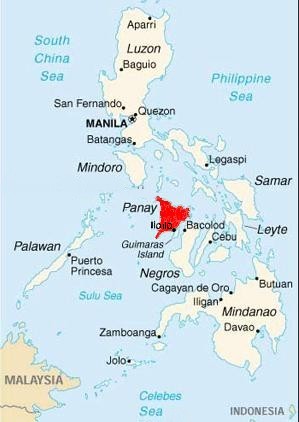

| Iloilo | Aug25-Sept 4, | Sept 11-13 | Iloilo (non-cycling) |
| Day 0 | Sept 3 | Sunday | Guimaras Island |
| Day 1 | Sept 5 | Tuesay | Iloilo to San Jose |
| Day 2 | Sept 6 | Wednesday | San Jose to Culasi |
| Day 3 | Sept 7 | Thursday | Culasi to Boracay |
| Day 4 | Sept 8 | Friday | Boracay to Kalibo |
| Day 5 | Sept 9 | Saturday | Kalibo to Passi |
| Day 6 | Sept 10 | Sunday | Passi to Iloilo |
| Conclusion | |||
| Miles |
In the fall of 2000 I had the opportunity to spend three weeks on Panay Island in the Philippines. Of course, I brought my bike along and managed to do a 6-day solo self-supported tour while I was there. To understand why I went to the Philippines, I must first tell you a little history.
After 330 years of Spanish rule, the Philippine islands became an American colony in 1898 after the Spanish-American war. Filipino freedom fighters fought alongside American forces, whom they were assured came as liberators. However in December, the peace treaty between America and Spain ceded the Philippines to the US. A bloody civil war followed, which America put down ruthlessly.
America's less-than-honorable conduct in the war was followed by much more enlightened government of its new colony. One of the first things the military administration did was to set up schools throughout the islands. Soon the military-run schools were replaced by civilian ones, often set up under the auspices of church missionary groups from America. My grandparents were part of that movement.
| |
| My grandmother and mother in their home in Iloilo, circa 1920 |
 They arrived with their two-year-old daughter (my Mother) in 1919 to
teach and administer a Baptist missionary school in the city of Iloilo on
the island of Panay, one of the central (Visayan) islands in the Philippine
archipelago. Within a few years, my grandfather, Dr. Harland F. Stuart,
(who was himself a cyclist!)
became the first President
of the new two-year college that was set up, which became a full-fledged
four-year institution before they left in 1939. At that time there were
about 400 students. Today
Central Philippine University
(CPU) has an enrollment of over 11,000.
They arrived with their two-year-old daughter (my Mother) in 1919 to
teach and administer a Baptist missionary school in the city of Iloilo on
the island of Panay, one of the central (Visayan) islands in the Philippine
archipelago. Within a few years, my grandfather, Dr. Harland F. Stuart,
(who was himself a cyclist!)
became the first President
of the new two-year college that was set up, which became a full-fledged
four-year institution before they left in 1939. At that time there were
about 400 students. Today
Central Philippine University
(CPU) has an enrollment of over 11,000.
My mother left in 1935 at age 17 to attend college in the States and
never returned. My mission to the Philippines was to take Mom back to
the land of her youth
after an absence of 65 years. My uncle Dave had returned to CPU with his
wife Hazel two years previously to be a consultant to their TV/video
department and acted as our host while we were there. Mom and I stayed
at a hotel just a couple blocks from the CPU back gate.
Last updated November 22, 2021